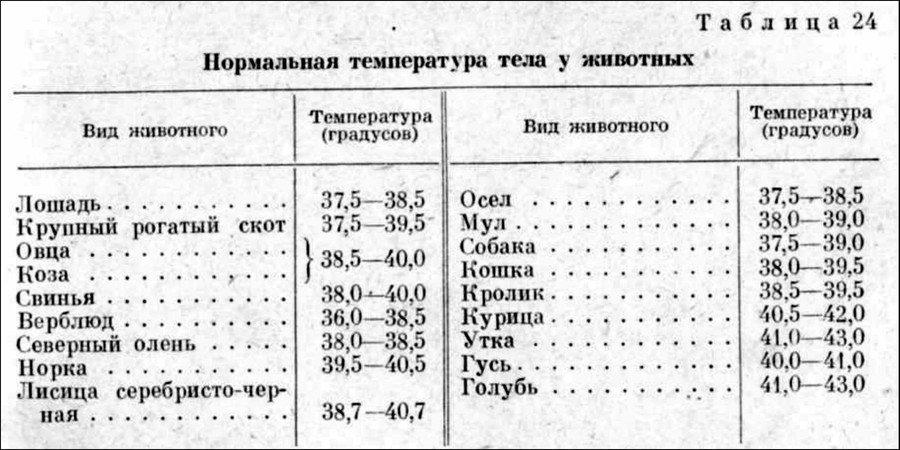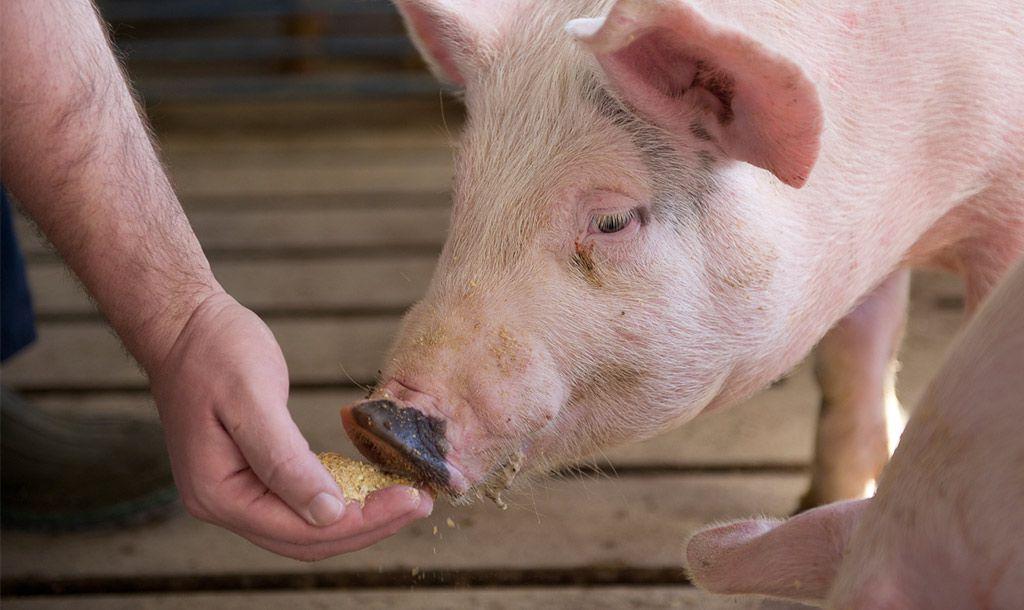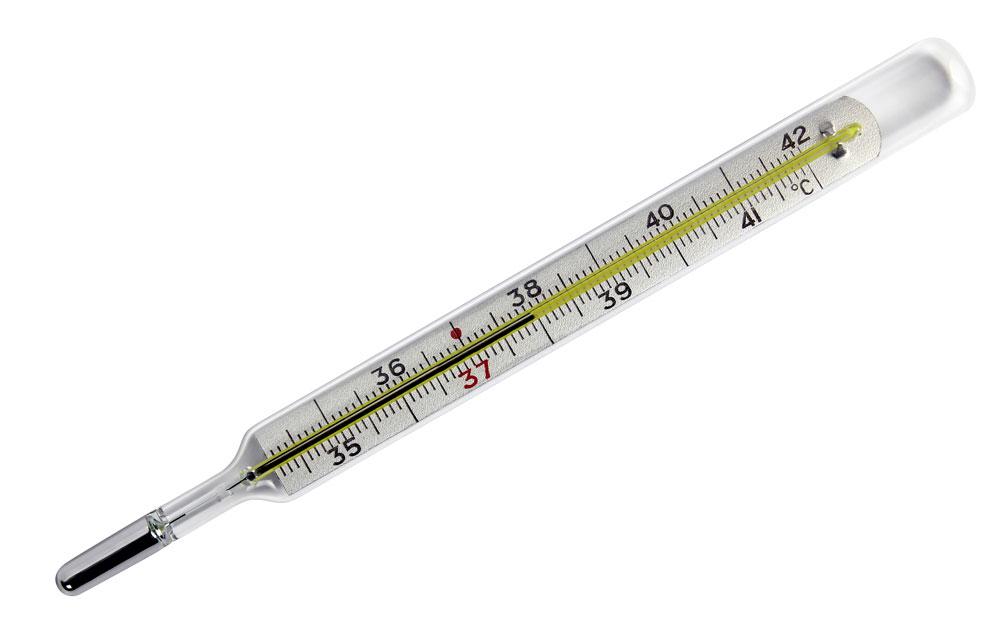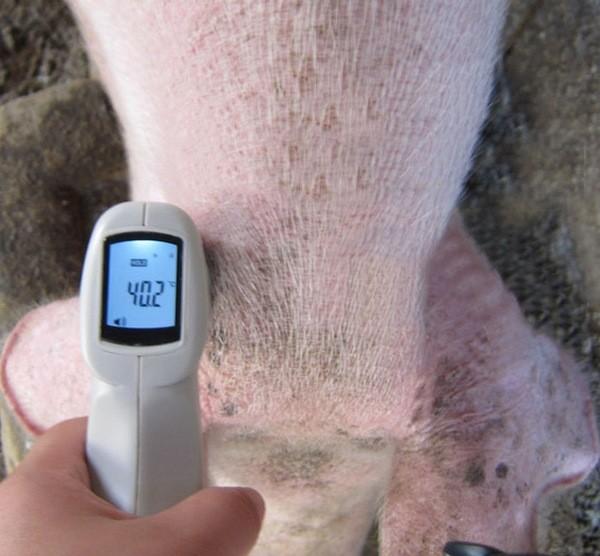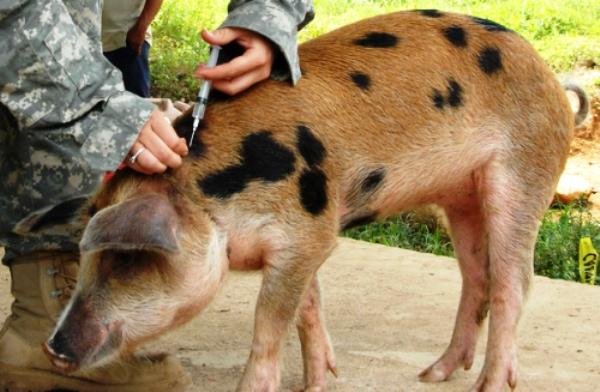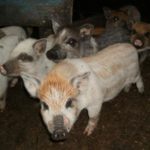An increase in temperature in pigs indicates the development of a pathological process, which in a pregnant female can provoke the birth of still babies. Sick piglets are stunted in growth, do not gain weight and die when the temperature persists for a long time, since protein cells in the body are destroyed. Adult animals are sometimes left with other livestock and given medication. Sick little piglets are kept separately; healthy young piglets push them away from the feeder.
Normal body temperature in pigs
Animals suffer from invasion of parasites and become infected with bacteria and viruses. Infected meat cannot be sold, sick piglets die, and the farmer suffers losses. The body temperature of a pig of an ordinary breed is normally up to 39.5 ° C, and does not fall below 38. In pregnant and lactating females, the figure is slightly higher than in males.
The thermometer in healthy ornamental pigs under one year of age rises one notch higher. In small piglets, activity remains at 40 ° C, but the young react strongly to any change in the external environment.
Signs of deviation from the norm
When feeding animals, you need to pay attention to the appetite and the speed of eating food. In individuals with elevated temperature:
- a rash appears on the body;
- breathing becomes difficult;
- eyes water and shine;
- the stubble is tousled;
- mucus is released from the nose and mouth.
The piglet's snout acquires a bright red tint, becomes hot to the touch, vomiting and diarrhea often occur, and the heartbeat quickens. Over time, symptoms characteristic of a particular disease are added.
If the animal’s temperature is high, immediate action must be taken; if it decreases from the norm in the morning, treatment is not required; this phenomenon does not indicate an illness, but the normal physiological state of the piglet.
Reasons for promotion and demotion
In an adult pig, frozen, moldy food provokes a high temperature. Rough food and products contaminated with parasites irritate the gastric mucosa. The membrane becomes inflamed and indigestion occurs.
When consuming low-quality feed, sows' nipples harden, milk stagnates in the ducts, which causes mastitis, which is accompanied by a strong and sharp rise in temperature.
The indicator increases slightly with vitamin deficiency. Sometimes, when feeding with rough food, the female’s milk completely disappears. The thermometer rises significantly when a pig is sick:
- pneumonia;
- gastroenteritis;
- bronchitis.
Infectious pathologies are treated with antibiotics, after recovery the animals are walked in the sun, and the pigs are given vitamins. In piglets, body temperature is influenced by the environment. In hot weather the indicator is higher, in cold weather it is lower. At the same time, little pigs eat well and do not lose activity.
What and how can you measure temperature?
If the pig refuses to feed, becomes lethargic, trembles, buries itself in the litter, drinks a lot, you should touch the snout, feel the ears, and only then measure the temperature. This procedure is complicated; even a calm animal can become aggressive and not be allowed to approach you.
Mercury thermometer
To measure the temperature, you should approach the pig from behind, pet it, talk to it in a gentle voice, and give it your favorite food. When the piglet calms down, quickly insert a mercury thermometer into the anus and hold it for 8 minutes. If the animal is nervous or behaves aggressively, you need to postpone the procedure for a while.
Electric thermometer
Not every farmer can afford to purchase an innovative device that is compact in size and acts like a thermocouple. Such a thermometer is expensive, but when applied to the body it instantly records the value.
Digital Thermometer
In order not to torment the piglet, and to quickly cope with rectal measurements, you should look for a modern electronic thermometer in veterinary pharmacies.The entire procedure using the device takes a minute. Pyrometer (Infrared thermometer) The device allows you to take measurements in a second from pigs and wild boars when applied to any part of the body. The result is displayed on the liquid crystal screen.
How to determine temperature without a thermometer
A veterinarian’s help is needed if the pig’s eyes are red, the bristles have become dull, spots have appeared on the body, there is diarrhea, and there is no appetite. You can determine that an animal has a high temperature without a device by feeling the hot spot. Floppy ears also indicate a deviation.
If the piglet is shaking from chills, trying to warm up in the bedding, hiding its cold legs, this indicates a decrease in temperature. Intoxication of the animal’s body develops:
- for diseases of the urinary system;
- with kidney damage;
- with a large number of helminths.
A little pig is constantly freezing due to rickets. To raise the pig's temperature and restore weight gain, it is advised to walk it in the sun more often.
How to treat?
Beginning farmers do not always know what to do if an animal refuses to eat food or behaves unusually. Adult pigs cannot easily tolerate high temperatures, and piglets can die. If the reading is above 40.5 °C, it is recommended to call a veterinarian. If a specialist does not arrive in the next 24 hours to bring down the temperature, the animals are given antipyretic drugs and injected with antibiotics. Piglets are injected with penicillin or Tetracycline and isolated from healthy individuals.
Almost half of the diseases in pigs are related to nutrition. Spoiled feed, insufficient amounts of vitamins, easily digestible protein, and microelements in the diet provoke digestive disorders in adult animals and cause gastroenteritis in piglets.For chronic diarrhea, pigs are given a decoction of oak bark and the stomach is washed with saline solution. Nursing females and babies are administered Norsulfazole and Biomycin.
Animals suffering from tracheitis or bronchopneumonia are transferred to a dry room, walked in the sun, coughing piglets are warmed with an ultraviolet lamp, and fed carrots, oatmeal, and barley porridge. If purulent lesions have formed in the lungs, the pigs will not survive. To remove mucus from the bronchi, piglets are given ammonium chloride to drink. For pneumonia, the veterinarian recommends administering antibiotics and sulfonamides.
Pigs become infected with diseases accompanied by rising temperatures from rats, mice, and pigeons. A vaccine is administered for prevention and treatment.
Foot and mouth disease, in which the oral mucosa, skin, limbs, and udder become covered with blisters, the temperature rises, affects both adults and piglets. To combat the filter virus that causes foot and mouth disease, globulins obtained from the serum of healthy animals are used. For all infectious diseases, piglets are transferred to a separate room, which is regularly disinfected; a treatment regimen is drawn up by a veterinarian.
Pigs suffer from ascariasis, caused by roundworms. To cope with parasites, Piperazine salts are given to animals along with food. Manure is burned, drinking bowls are disinfected, equipment is treated with carbolic acid or creolin solution. A veterinarian helps the farmer determine the cause of lethargy and high temperature in piglets.

